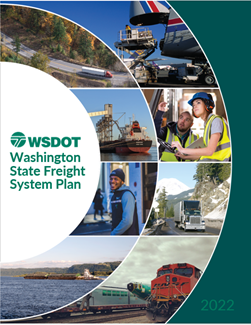Freight System Plan
The Washington Freight System Plan examines all modes of freight movement -- including trucks, airplanes, rail, barges and cargo ships.
The efficient, safe and reliable transportation of goods throughout Washington is critical to every aspect of economic and community vitality in the Pacific Northwest. The Washington Freight System Plan sets the vision for the state’s multimodal freight system and supports collaboration with public and private partners. WSDOT will update this plan every four years.

2022 Freight System Plan
WSDOT released the 2022 Freight System Plan in December 2022 and will use it to guide future freight transportation policies, programs, and investments. This plan fulfills the federal freight planning requirements under the Bipartisan Infrastructure Law and supports Washington state’s six transportation policy goals. It was developed collaboratively with public and private partners and reflects the feedback gathered throughout the plan outreach process.
The final plan includes an easy-to-read main plan and a series of technical appendices that provide additional details for different elements of the plan.
2022 Washington State Freight System Plan (PDF 5KB)
- Appendix A - Federal Conformance (PDF 207KB) - Outlines how this plan follows federal planning requirements.
- Appendix B - Outreach Summary (PDF 481KB) - Documents the outreach activities undertaken to create this plan, including the stakeholder outreach process, thematic findings, and how the findings were used within the plan.
- Appendix C - Supply Chains (PDF 15MB) - Documents the economic context for the Washington multimodal freight system including population trends, economic trends, the role of freight-dependent industries, and Washington supply chains that depend on the freight system.
- Appendix D - Freight System (PDF 4MB) - Documents the inventory of multimodal freight infrastructure and facilities (both public and privately owned) in Washington, including major freight activity centers. The inventory captures Washington’s road freight network, rail freight network, maritime network, air cargo network, and pipeline network.
- Appendix E - System Performance (PDF 12MB) - Provides an assessment of the current conditions and performance of the multimodal freight system in Washington.
- Appendix F - Needs, Issues and Potential Improvements (PDF 6MB) - Describes the identified freight needs and issues associated with each of the statewide policy goals over the short, medium, and long-term. The document also contains potential improvement strategies to address the identified needs and issues and suggested owners and partners.
- Appendix G - Freight Investment Plan (PDF 3MB) - Describes how WSDOT will spend the federal National Highway Freight Program funding that it receives, and the process that was used to identify and select projects for funding.
- Appendix H - Truck Parking Assessment (PDF 14MB) - Includes a new truck parking inventory, a truck parking needs review and an analysis of truck parking conditions.
Data and Tools
As part of the 2022 Freight System Plan, new freight data and tools for use by public and private partners are available:
-
Freight Plan interactive storymap –visually shows how different supply chains of key freight industries work in Washington state, including agriculture, food manufacturing, forestry, and aerospace manufacturing.
-
Freight data visualization dashboard – allows users to explore the value, tonnage, commodity, and mode of freight flows traveling to, from and within Washington. It also allows users to filter and download freight flow data by years, trade types, and origin-destination pairs at county and MPO/RTPO level.
Additional resources
-
FHWA Freight Professional Capacity Building Program – provides assistance and resources to freight practitioners at the State DOT, MPO and local agency level.
Slow down – lives are on the line.
Excessive speed was a top cause of work zone collisions in 2024.
Phone down, eyes up.
Work zones need our undivided attention.
It's in EVERYONE’S best interest.
96% of people hurt in work zones are drivers, their passengers or passing pedestrians, not just our road crews.
